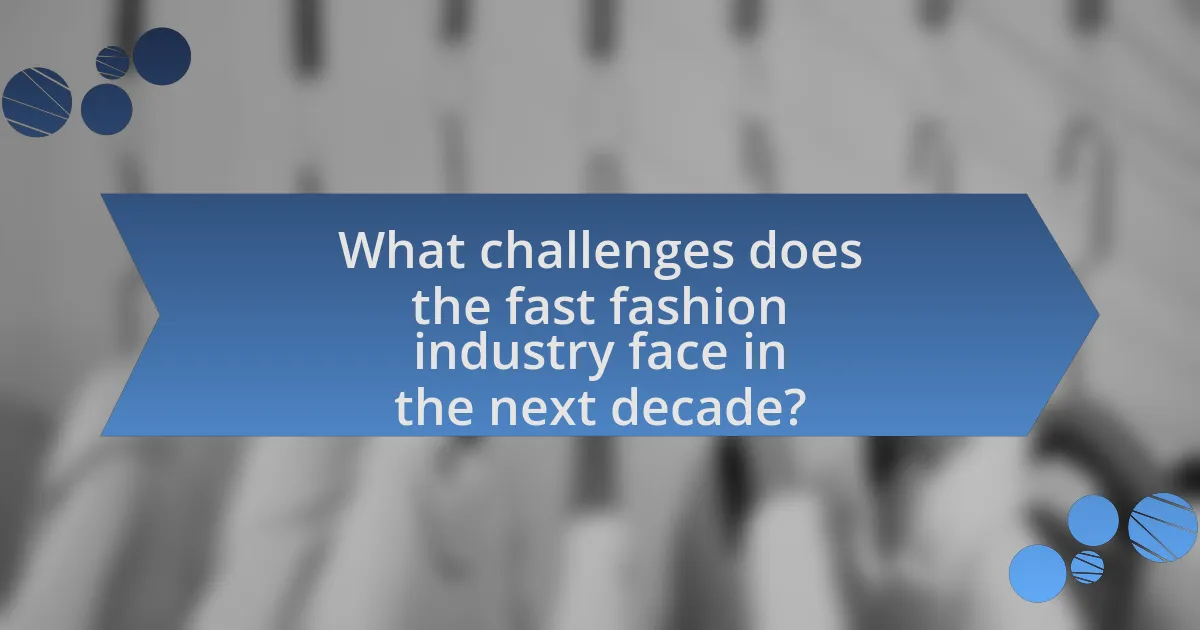The article examines the future of fast fashion, highlighting key trends such as sustainability, digital transformation, and consumer demand for personalization. It discusses how sustainability is reshaping the industry, with brands adopting eco-friendly practices and materials in response to consumer preferences. The role of technology, particularly in enhancing supply chain efficiency and enabling personalized shopping experiences, is also explored. Additionally, the article addresses the challenges fast fashion faces, including regulatory pressures and evolving consumer behaviors, while emphasizing the importance of circular fashion and innovative materials in promoting sustainability.

What are the key trends shaping the future of fast fashion?
Key trends shaping the future of fast fashion include sustainability, digital transformation, and consumer demand for personalization. Sustainability is increasingly prioritized, with brands adopting eco-friendly materials and practices; for instance, a report by McKinsey & Company indicates that 67% of consumers consider sustainability when making a purchase. Digital transformation is also pivotal, as brands leverage technology for supply chain efficiency and enhanced customer experiences, evidenced by the rise of AI-driven inventory management. Lastly, consumer demand for personalization drives brands to offer tailored shopping experiences, supported by data showing that 80% of consumers are more likely to purchase from a brand that offers personalized experiences.
How is sustainability influencing fast fashion’s evolution?
Sustainability is significantly influencing fast fashion’s evolution by driving brands to adopt eco-friendly practices and materials. As consumer awareness of environmental issues increases, fast fashion retailers are responding by integrating sustainable sourcing, reducing waste, and implementing circular economy principles. For instance, a 2021 McKinsey report highlighted that 67% of consumers consider sustainability when making a purchase, prompting brands like H&M and Zara to launch sustainable collections and commit to carbon neutrality by 2040. This shift not only aligns with consumer demand but also addresses regulatory pressures and the need for long-term viability in a market increasingly focused on environmental responsibility.
What sustainable practices are being adopted by fast fashion brands?
Fast fashion brands are adopting several sustainable practices, including the use of recycled materials, implementing circular fashion initiatives, and enhancing supply chain transparency. For instance, brands like H&M and Zara are incorporating recycled polyester and organic cotton into their collections, which reduces reliance on virgin resources. Additionally, initiatives such as take-back programs and clothing recycling schemes are being introduced to promote circularity, allowing consumers to return used garments for recycling or repurposing. Furthermore, many fast fashion companies are increasing transparency in their supply chains by publishing sustainability reports and disclosing information about their sourcing practices, which helps consumers make informed choices. These practices are part of a broader trend towards sustainability in the fashion industry, driven by consumer demand for environmentally responsible products.
How do consumers’ preferences for sustainability impact fast fashion?
Consumers’ preferences for sustainability significantly impact fast fashion by driving brands to adopt more eco-friendly practices. As awareness of environmental issues grows, consumers increasingly demand transparency regarding sourcing, production methods, and labor practices. This shift has led fast fashion companies to implement sustainable materials, reduce waste, and improve supply chain ethics to meet consumer expectations. For instance, a 2021 survey by McKinsey & Company found that 67% of consumers consider sustainability when making a purchase, prompting brands like H&M and Zara to launch sustainable collections. Consequently, fast fashion is evolving to align with these preferences, influencing its operational strategies and market positioning.
What role does technology play in the future of fast fashion?
Technology is pivotal in shaping the future of fast fashion by enhancing efficiency, sustainability, and consumer engagement. Innovations such as artificial intelligence and data analytics enable brands to predict trends and optimize inventory management, reducing waste and overproduction. For instance, companies like Zara utilize AI to analyze customer preferences in real-time, allowing for quicker design and production cycles. Additionally, advancements in sustainable materials and manufacturing processes, such as 3D printing and biodegradable fabrics, are being integrated to address environmental concerns. According to a report by McKinsey & Company, the adoption of digital technologies in fashion can lead to a 30% reduction in production costs and a significant decrease in carbon emissions, underscoring technology’s critical role in the industry’s evolution.
How are advancements in technology changing production processes?
Advancements in technology are significantly transforming production processes by enhancing efficiency, reducing costs, and enabling customization. For instance, the integration of automation and robotics in manufacturing allows for faster production cycles and minimizes human error, leading to increased output. According to a report by McKinsey & Company, companies that adopt advanced manufacturing technologies can achieve productivity gains of up to 30%. Additionally, technologies such as 3D printing facilitate on-demand production, allowing brands to respond quickly to market trends and consumer preferences, thereby reducing waste and inventory costs. These technological innovations are reshaping the landscape of production in the fast fashion industry, driving a shift towards more sustainable and agile manufacturing practices.
What impact does e-commerce have on fast fashion’s growth?
E-commerce significantly accelerates the growth of fast fashion by providing brands with a global platform to reach consumers instantly. The convenience of online shopping allows fast fashion retailers to quickly respond to trends and consumer demands, leading to increased sales and market expansion. For instance, in 2020, online sales accounted for 27.6% of total retail sales in the U.S., highlighting the shift towards digital shopping. This shift enables fast fashion companies to launch new collections rapidly, often within weeks, thereby capitalizing on current trends and consumer preferences. Additionally, e-commerce reduces overhead costs associated with physical stores, allowing brands to invest more in marketing and product development, further driving growth in the fast fashion sector.
How are consumer behaviors evolving in the fast fashion market?
Consumer behaviors in the fast fashion market are evolving towards increased sustainability and ethical considerations. A significant shift is observed as consumers, particularly younger demographics, prioritize eco-friendly materials and ethical production practices over low prices and rapid trends. According to a 2021 McKinsey report, 67% of consumers consider the use of sustainable materials important when making fashion purchases, indicating a growing demand for transparency in sourcing and manufacturing. Additionally, the rise of second-hand shopping and rental services reflects a change in consumer values, with platforms like Depop and Rent the Runway gaining popularity as alternatives to traditional fast fashion. This evolution signifies a broader cultural shift towards responsible consumption in the fashion industry.
What factors are driving changes in consumer purchasing decisions?
Changes in consumer purchasing decisions are primarily driven by sustainability concerns, technological advancements, and shifting social values. Consumers increasingly prioritize eco-friendly products, with 66% of global consumers willing to pay more for sustainable brands, according to a Nielsen report. Additionally, the rise of e-commerce and mobile shopping has transformed how consumers access and evaluate products, leading to more informed purchasing decisions. Social media influences, particularly through platforms like Instagram and TikTok, also shape consumer preferences by promoting trends and brand visibility. These factors collectively indicate a significant shift towards more conscious and informed consumer behavior in the fast fashion industry.
How does social media influence fast fashion trends?
Social media significantly influences fast fashion trends by rapidly disseminating information and visual content, which shapes consumer preferences and purchasing behaviors. Platforms like Instagram and TikTok allow brands to showcase new collections and styles instantly, creating a sense of urgency and desire among consumers. For instance, a study by McKinsey & Company found that 70% of consumers are influenced by social media when making fashion purchases, highlighting the direct correlation between social media engagement and fast fashion sales. Additionally, the viral nature of trends on these platforms can lead to quick turnover in styles, prompting brands to produce new items at an accelerated pace to meet consumer demand.

What challenges does the fast fashion industry face in the next decade?
The fast fashion industry will face significant challenges in the next decade, primarily due to increasing consumer demand for sustainability and ethical production practices. As awareness of environmental issues grows, consumers are increasingly favoring brands that prioritize eco-friendly materials and transparent supply chains. For instance, a 2021 survey indicated that 66% of global consumers are willing to pay more for sustainable brands, highlighting a shift in purchasing behavior. Additionally, regulatory pressures are mounting, with governments worldwide implementing stricter environmental regulations aimed at reducing waste and carbon emissions in the fashion sector. This combination of consumer expectations and regulatory frameworks will compel fast fashion brands to adapt or risk losing market share.
How are regulatory changes affecting fast fashion brands?
Regulatory changes are significantly impacting fast fashion brands by imposing stricter environmental and labor standards. These regulations require brands to adopt sustainable practices, such as reducing waste and ensuring fair labor conditions, which can increase operational costs. For instance, the European Union’s Green Deal aims to make the fashion industry more sustainable by mandating transparency in supply chains and reducing carbon emissions. As a result, fast fashion brands are compelled to innovate and invest in sustainable materials and ethical production methods to comply with these regulations, ultimately reshaping their business models.
What specific regulations are being implemented globally?
Specific regulations being implemented globally include the European Union’s Sustainable Textile Strategy, which aims to make textiles more sustainable by promoting circular economy practices and reducing waste. Additionally, the Fashion Sustainability and Social Accountability Act in New York mandates large fashion retailers to disclose their supply chain practices and environmental impact. These regulations reflect a growing trend towards accountability and sustainability in the fashion industry, driven by consumer demand and environmental concerns.
How can fast fashion brands adapt to these regulatory changes?
Fast fashion brands can adapt to regulatory changes by implementing sustainable practices and enhancing transparency in their supply chains. By investing in eco-friendly materials and production processes, brands can comply with environmental regulations while appealing to increasingly conscious consumers. For instance, the European Union’s Green Deal aims to make the fashion industry more sustainable, pushing brands to reduce waste and carbon emissions. Additionally, adopting technologies that track and report supply chain practices can help brands meet new transparency requirements, as seen in the Fashion Transparency Index, which evaluates brands on their disclosure of supply chain information. This proactive approach not only ensures compliance but also strengthens brand reputation and customer loyalty.
What are the economic implications for fast fashion in the future?
The economic implications for fast fashion in the future include increased costs due to regulatory pressures and shifting consumer preferences towards sustainability. As governments implement stricter environmental regulations, fast fashion brands may face higher production costs, impacting profit margins. Additionally, a growing consumer demand for ethical and sustainable practices is likely to force these brands to invest in more sustainable materials and production processes, further increasing operational expenses. For instance, a report by McKinsey & Company indicates that the global fashion industry could lose up to $65 billion by 2025 if it fails to adapt to sustainability trends. This shift may lead to a consolidation of the market, where only brands that successfully integrate sustainable practices can thrive economically.
How does economic instability impact fast fashion sales?
Economic instability negatively impacts fast fashion sales by reducing consumer spending power and increasing price sensitivity. During periods of economic downturn, consumers prioritize essential goods over discretionary purchases, leading to decreased demand for fast fashion items. For instance, a study by McKinsey & Company in 2020 indicated that 75% of consumers planned to cut back on non-essential spending due to economic uncertainty caused by the COVID-19 pandemic. This shift in consumer behavior results in lower sales volumes for fast fashion retailers, as they rely heavily on impulse purchases and frequent buying cycles.
What strategies can fast fashion brands employ to remain profitable?
Fast fashion brands can remain profitable by adopting sustainable practices, enhancing supply chain efficiency, and leveraging digital marketing strategies. Sustainable practices, such as using eco-friendly materials and reducing waste, can attract environmentally conscious consumers, which is increasingly important as 66% of global consumers are willing to pay more for sustainable brands. Enhancing supply chain efficiency through technologies like AI and data analytics can reduce costs and improve inventory management, allowing brands to respond quickly to market trends. Additionally, leveraging digital marketing strategies, including social media engagement and influencer partnerships, can increase brand visibility and drive sales, as 75% of consumers are influenced by social media in their purchasing decisions.

What innovations are expected to emerge in fast fashion?
Innovations expected to emerge in fast fashion include advanced sustainable materials, AI-driven design processes, and enhanced supply chain transparency. Sustainable materials, such as bio-fabricated textiles and recycled fibers, are being developed to reduce environmental impact. AI-driven design processes enable brands to predict trends and consumer preferences more accurately, leading to quicker turnaround times. Enhanced supply chain transparency is facilitated by blockchain technology, allowing consumers to trace the origins of their garments, thereby promoting ethical practices. These innovations are driven by increasing consumer demand for sustainability and ethical production in the fashion industry.
How is the concept of circular fashion being integrated into fast fashion?
The concept of circular fashion is being integrated into fast fashion through initiatives that promote recycling, upcycling, and sustainable materials. Fast fashion brands are increasingly adopting take-back programs that allow consumers to return used garments for recycling or resale, thereby reducing waste. For example, H&M’s Garment Collecting initiative has collected over 30,000 tons of textiles since its launch, demonstrating a commitment to circularity. Additionally, brands are investing in sustainable materials, such as organic cotton and recycled polyester, to minimize their environmental impact. This shift not only aligns with consumer demand for sustainability but also addresses regulatory pressures for more responsible production practices.
What are the benefits of circular fashion for fast fashion brands?
Circular fashion offers fast fashion brands several benefits, including enhanced sustainability, improved brand reputation, and increased customer loyalty. By adopting circular practices, such as recycling and upcycling materials, brands can significantly reduce waste and resource consumption, aligning with growing consumer demand for environmentally responsible practices. Research indicates that 66% of consumers are willing to pay more for sustainable brands, demonstrating that circular fashion can attract a more conscientious customer base. Additionally, implementing circular systems can lead to cost savings in the long term through reduced material costs and waste management expenses. Thus, circular fashion not only addresses environmental concerns but also provides economic advantages for fast fashion brands.
How can consumers participate in circular fashion initiatives?
Consumers can participate in circular fashion initiatives by engaging in practices such as buying second-hand clothing, participating in clothing swaps, and supporting brands that prioritize sustainability. These actions contribute to reducing waste and extending the lifecycle of garments. For instance, the global second-hand market is projected to reach $64 billion by 2024, indicating a growing consumer preference for sustainable options. Additionally, participating in clothing swaps not only promotes reuse but also fosters community engagement, further enhancing the circular economy.
What new materials and fabrics are being developed for fast fashion?
Innovative materials and fabrics being developed for fast fashion include bio-based textiles, recycled polyester, and smart fabrics. Bio-based textiles, such as those made from organic cotton or algae, reduce environmental impact while offering sustainable alternatives. Recycled polyester, derived from post-consumer plastic bottles, is gaining traction for its ability to minimize waste and resource consumption. Smart fabrics, which incorporate technology for functionalities like moisture-wicking or temperature regulation, are also emerging, enhancing the performance and appeal of fast fashion items. These advancements reflect a growing industry trend towards sustainability and functionality in clothing production.
How do these materials contribute to sustainability in fast fashion?
Sustainable materials contribute to sustainability in fast fashion by reducing environmental impact and promoting resource efficiency. For instance, organic cotton uses 91% less water than conventional cotton, significantly lowering water consumption in the production process. Additionally, recycled polyester, derived from plastic bottles, diverts waste from landfills and reduces reliance on virgin petroleum-based materials, thus decreasing carbon emissions associated with production. Furthermore, materials like Tencel, made from sustainably sourced wood pulp, utilize a closed-loop process that recycles water and solvents, minimizing pollution. These practices collectively enhance the sustainability profile of fast fashion brands, aligning with consumer demand for eco-friendly products.
What are the challenges in sourcing innovative materials?
Sourcing innovative materials presents several challenges, including high costs, limited availability, and regulatory hurdles. High costs arise from the research and development required to create new materials, which can deter manufacturers from adopting them. Limited availability is often due to the nascent stage of innovative materials, where production capacity has not yet scaled to meet demand. Regulatory hurdles can complicate the introduction of new materials, as compliance with environmental and safety standards is necessary before they can be widely used in production. These challenges collectively hinder the integration of innovative materials into fast fashion, impacting sustainability efforts and market competitiveness.
What practical steps can consumers take to navigate the future of fast fashion?
Consumers can navigate the future of fast fashion by prioritizing sustainable brands and making informed purchasing decisions. By choosing brands that emphasize ethical production practices, consumers can support environmentally friendly initiatives. Research indicates that the global sustainable fashion market is projected to reach $8.25 billion by 2023, reflecting a growing consumer demand for responsible fashion choices. Additionally, consumers should consider buying second-hand clothing, which reduces waste and extends the lifecycle of garments. According to ThredUp’s 2021 Resale Report, the second-hand market is expected to double in the next five years, highlighting its increasing popularity. Lastly, consumers can educate themselves about the environmental impact of their clothing choices, fostering a more conscious approach to fashion consumption.
How can consumers make more sustainable choices in fast fashion?
Consumers can make more sustainable choices in fast fashion by prioritizing brands that use eco-friendly materials and ethical labor practices. Research indicates that approximately 60% of consumers are willing to change their shopping habits to reduce environmental impact, highlighting a growing awareness of sustainability. Additionally, consumers can opt for second-hand clothing, which reduces waste and extends the lifecycle of garments. According to a study by ThredUp, buying used clothing can save up to 80% of the carbon footprint compared to purchasing new items. Engaging in clothing swaps and supporting local sustainable brands further enhances sustainable consumption in the fast fashion sector.
What resources are available for consumers to stay informed about fast fashion trends?
Consumers can stay informed about fast fashion trends through various resources such as fashion blogs, social media platforms, industry reports, and sustainability websites. Fashion blogs like The Business of Fashion provide insights into market trends and brand strategies, while social media platforms like Instagram and TikTok showcase real-time fashion trends and influencer styles. Industry reports from organizations like McKinsey & Company offer data-driven analyses of the fast fashion sector, highlighting consumer behavior and market forecasts. Additionally, sustainability websites such as Fashion Revolution educate consumers on ethical practices and the environmental impact of fast fashion, fostering informed decision-making.















